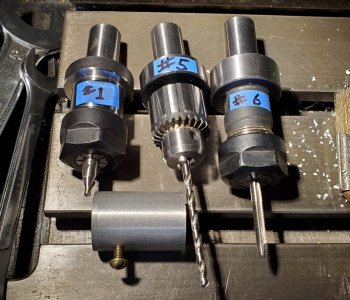One of the sites I spend time on occasionally has a thread for supporting the UHU DC Servo drives. A bit of background. Uli Uber (sp?) in Germany designed a DC servo drive driven by an 8 bit Atmel processor (around 2005) He also published the schematic and circuit board layout and a number of people around the world built some boards. I bought one from Manjeet in India. To make the boards work you had to buy the processor and crystal from Uli for the price of a beer or thereabouts. Here's mine.

It worked well enough that a guy with the id Kreutz took the design and redid it to handle much higher voltage and current along with both a continuous and max current setting. Still used the same processor from Uli. Requries 15V and of course whever high voltage you might want for the motor. The encoder circuit was now also differential to combat noise. I had two of these set up on my mill for X and Y until discovered that the X motor had issues and kept loosing steps. Which is why it's nice to keep the DRO on the machine even if you go CNC. The one mistake I made was using the wrong polarity on the DB-9 for terminal communications. It's optically isolated too so it needs that USB connector for the PC side 5V.

The next step in this project was done by Henrik Olsson in Sweden. He developed a little companion board with a PIC18 that had quadrature encoder support so that higher res encoders running at higher RPM could be used. He wrote his own code which he claimed was less sensitive to encoder noise because of the hardware QEI. Because of my X axis losing steps issue I bought a couple.
That cleaned up most of my problems but every once in a while the HP_UHU still had issues so eventually I moved to the Bergerda AC Servos since the cost of a replacement motor was the same as a 400W servo with drive and no power supply was needed. And because I was in the market for a 3 phase spindle motor and VFD I checked the price of that verses a 1.8kW AC Servo and the two motors with drives ended up being cheaper.
So why the story? Well Kreutz vanished for a while but recently returned to the UHU forum. And chatting with him about my issues with wanting a constant torque mode for my Draw Bar he found this thread on the forum.
Last night, thanks to some prodding from a friend, I finally got off my lazy a\\\$\\\$ and designed up the stepper-driven power drawbar I've been wanting
www.cnczone.com
Seems this fellow, Ray Livingston, has done the same thing that I wanted to do except he's using a 400 oz-in stepper, 55:1 planetary reduction, a Gecko stepper Drive with a relay to change motor current by adding in a resistor. Way back in 2012.
From the video it appears to work quite well. He's not posted anything since unfortunately. I've only ordered a 25:1 planetary reduction but then he's got the potential of 110 ft-lbs which is a tad high.
ie. 400 oz-in divided by 16 oz/lbs and 12"/ft is 2 ft-lbs static torque. With 55:1 that's a lot of static torque for a drawbar that doesn't need more than about 20 ft-lbs.
Finally to add one more thing to this story, Henrik Olsson is willing to help me update his code to a dsPIC that has hardware quadrature, PWM and CAN bus. A new module will be built that will replace the comparators used for detecting over current. With that, the ability to duplicate the german servo motor I used in that project I described in the previous posting will be possible.
Anyway. That's about it on this for now. Next step is to machine up a Size 23 mounting plate for the surplus PA motor in the first picture. Then do some testing to see if it's got the torque to do what I want while I wait for the reduction drive.
edit: The motor in the previous posting was French not German.
https://sonceboz.com/en/



